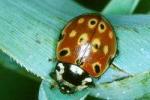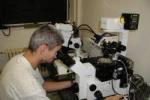Research activities of the Institute of Entomology
Mission statement
The Institute carries on taxonomic, genetic, physiological, molecular and ecological investigations on a wide range of model insect species and model ecosystems.
General information
The Institute was founded within the Czechoslovak Academy of Sciences in 1962 by a merger of a Laboratory of Entomology and the Department of Insect Pathology, which existed since 1953. The Institute expanded to five Departments scattered throughout Prague until 1985, when most of the staff moved to the present building in the town of České Budějovice. The Institute harbors the editorial office of the European Journal of Entomology.
The Institute originally focused on applied entomology and has generated more than 150 patents applicable in agriculture and forestry. They have been primarily concerned with production of bioagents for the pest control, introduction of pheromones for pest signalling, development and application of juvenile hormone analogues, etc. The discovery of the immunosuppressive cyclosporine was a very important side-product of research on entomopathogenic fungi. Other practical contributions were made in the area of nature conservation and environment protection.
The present staff of more than 100 (occupying 82 full-time positions) includes specialists ranging from molecular biologists to field ecologists. Research is supported by more than 30 grants and annual scientific output counts about 100 papers in renowned international journals (an interactive database of all publications is available on the Institute's webpage). Since 1962, the Institute has educated more than 140 PhDs and organised over 30 international meetings.
Research areas
Mechanisms of morphogenesis
chromosome structure and function, chromatin, sex chromosomes
regulation of gene expression and differentiation
transcription factors, hormone action
Insect physiology and developmental biology
- regulation of development and metabolism
- growth factors
- analytical biochemistry
Neurohumoral regulation of biorhythms and life cycles
- interactions between environmental factors and endogenous rhythms
- molecular mechanisms of circadian rhythmicity
- genetic control of biorhythms
- mechanisms of insect adaptations to seasonal and long-term changes of climate
Principles and mechanisms of biodiversity
- insect taxonomy
- molecular evolution
- evolutionary and population genetics
The role of insects in the structure and function of selected ecosystems
- the structure of insect communities in natural Central European and tropical ecosystem
- use of aquatic insects as bioindicators of environmental changes
- mathematical modelling of ecological processes
Biological control of insect pests and disease vectors
- genetic methods
- biorational pesticides, pathogens, predators and parasitoids
- environmental aspects of the use of genetically modified crops
International conference "DINFISH 2010"

















